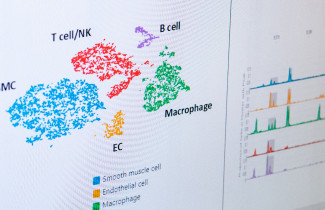The treatment of coronary artery disease could in the future target specific cell types in our body
“Coronary artery disease has, for a long time, been mainly treated with cholesterol-lowering drugs, but there is a need for other types of treatments as well. For example, new drugs could target pathogenic changes taking place in the arterial wall,” says the University of Eastern Finland’s newly appointed Professor of Cardiovascular Genomics Minna Kaikkonen-Määttä.
Elevated cholesterol levels are one factor in the vicious cycle of arterial disease, where cholesterol and inflammatory cells accumulate in the artery wall, causing blood vessels to become narrower and changing cell function in the artery wall. The disease usually also involves cellular changes in the adipose tissue and liver, which is an important regulator of cholesterol metabolism.
The role of different cell types in the progression of coronary artery disease, or in slowing it down, is not yet fully understood. According to Kaikkonen-Määttä, their significance in the disease process is probably different for different people, depending on an individual’s genetic code.
“Many genetic risk factors seem to affect smooth muscle cells that are the building blocks of the artery wall, while others may change the function of immune cells that clean up arteries from dead cells, foreign particles, and microbes, for example.”
“Hopefully in the future, we’ll be able to calculate individual risk profiles based on which tissue or cell type is genetically susceptible to disease, and to develop increasingly personalised treatments that target different cell types. Suitable treatments may also be found from among existing drugs that are used to treat other diseases.”
Nowadays, lipid and blood pressure lowering drugs are the gold standard in the treatment of coronary artery disease.
“We also need alternatives to these drugs, since some patients suffer from adverse side effects or the treatment is insufficient to prevent myocardial infarction and stroke.”
The new single cell genomics methods used by Kaikkonen-Määttä provide increasingly accurate information on how different cells contribute to the pathogenesis of coronary artery disease. Single cell technologies make it possible to explore gene function on the level of a single cell.
“Single cell technologies have completely revolutionised our research field. Using these technologies, it is now possible to examine tissue to accurately identify cells that have been affected and also to discover previously unknown cell types and genes involved in disease.”
Science named single cell technologies as the scientific breakthrough of 2018, and these technologies were quickly introduced also at the University of Eastern Finland, where the Centre for Single Cell Genomics, led by Kaikkonen-Määttä, was established. The services offered by the centre are soon being supplemented with spatial transcriptomics, which enables single cell analyses in their native tissue context.
“This will provide more detailed information on where the disease-associated gene expression changes and cell types are located within a tissue, and how the communication between the cells is altered as the disease progress.”
Gene regulation offers a new perspective on the risk of coronary artery disease
The risk of coronary artery disease is affected by both genes and environmental factors, such as lifestyles. Some 300 common genetic mutations that increase the risk of disease have already been identified. For a long time, however, only mutations in protein-coding regions preventing the production, or leading to defective production, of a certain protein, were considered significant.
“We know now that almost 90% of the risk variants are located in gene regulatory areas. In other words, they do not code for proteins, but affect protein production levels by regulating the level of gene expression. The significance of these mutations for the disease risk is only beginning to be understood, and it is precisely their effects that we are seeking to investigate in our own research.”
The Kaikkonen Lab has shown that many risk variants associated with coronary artery disease are specifically related to the function of vascular endothelial cells and smooth muscle cells, which highlights the important role of the cells of the vessel wall in the development of the disease. But in addition, they recently showed that more than one third of the general genetic mutations that increase the risk of disease are related to liver function, especially affecting the expression of genes that regulate cholesterol metabolism.
“It is more and more recognised that the risk variants act through many different tissues. Also, most of the risk variants cause rather subtle changes, and the genetic risk ultimately arises from their combined effect. Despite this complexity, it is extremely exciting to be part of the endeavour to annotate the molecular basis of human disease.”
Environmental factors, too, can change the function of genes. Indeed, the Kaikkonen Lab is conducting several studies on cells and mice to examine the effects of coronary artery disease associated lifestyles and conditions on the expression of genes. These studies have shown that the accumulation of fat in blood vessels caused by a high-cholesterol diet, for example, accelerates the expression of hundreds of genes associated with an inflammatory reaction.
“It is a distress signal from cells that are asking for help to clear out the harmful fat.”
“In the future, we also need to look for biomarkers that allow for an early detection of the changes that cardiovascular disease causes to the cells to better prevent and target the disease development before severe symptoms occur,” Kaikkonen-Määttä says.
Minna Kaikkonen-Määttä
- Professor of Cardiovascular Genomics, University of Eastern Finland, 1 January 2022–
- Born 1980
- BSc (cell biology and physiology / genetics) 2002, Claude Bernard Lyon I University, France
- MSc (molecular biology) 2005, University of Jyväskylä
- PhD 2008, University of Kuopio
- Title of Docent in Molecular Medicine 2014, University of Eastern Finland
Key roles
- Associate Professor (tenure track) and Academy Research Fellow, University of Eastern Finland, 2017–2021
- Research Group Director and Academy Research Fellow, University of Eastern Finland 2015–2017
- Postdoctoral Researcher, University of Eastern Finland, 2011–2015
- Postdoctoral Researcher, University of California, San Diego, US, 2009–2011
- Doctoral Researcher, Ark Therapeutics / University of Eastern Finland, 2004–2008
For further information, please contact:
Professor Minna Kaikkonen-Määttä, minna.kaikkonen (a) uef.fi, tel. +358 40 355 2415
https://uefconnect.uef.fi/en/person/minna.kaikkonen-maatta/
https://uefconnect.uef.fi/en/group/cardiovascular-genomics-kaikkonen-lab/
Print-quality photo:
https://mediabank.uef.fi/A/UEF+Media+Bank/41185?encoding=UTF-8



